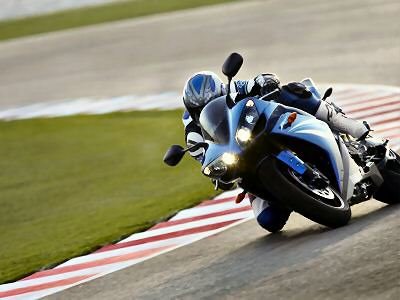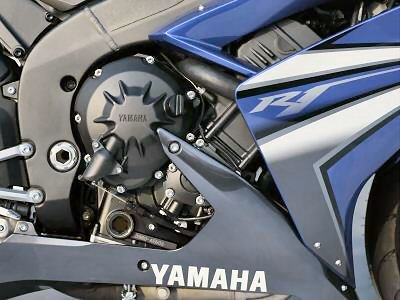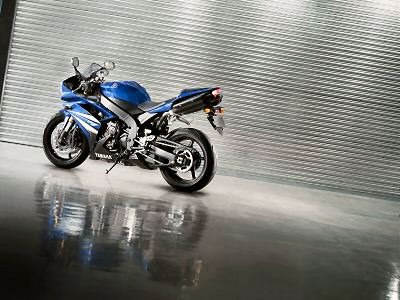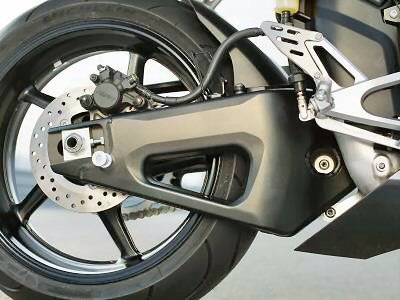2007 R1 Released: The juicy details
 Here are the big details, in Yamaha's words:
Here are the big details, in Yamaha's words:
New YCC-I (Yamaha Chip Controlled Intake)
The latest and most innovative product of the Yamaha G.E.N.I.C.H. engineering concept is YCC-I, which makes its debut on the 2007 YZF-R1, and is the first-ever electronically-controlled motor-driven variable intake on a production motorcycle. For over fifty years Yamaha have been at the forefront in the development of exciting new motorcycle technology, and the new YCC-I Yamaha Chip Controlled Intake system represents one of the most significant developments in electronic control ever seen in the supersport engine sector.
The intake passage length on an engine is designed to ensure the highest volumetric efficiency in the most commonly used rpm band for that particular powerplant. Generally speaking, a long intake passage and funnel tends to deliver stronger low to mid-range performance, and conversely a shorter intake passage and funnel is typically better for high rpm applications.
During the intake process on any four-stroke engine, the downwards motion of the piston creates negative pressure in the intake passage, which causes a pressure difference with the air and its natural inertia. This pressure difference causes a reverse reaction in the direction of the intake valve in a function known as ‘inertial charging’, and this phenomenon increases the engine’s volumetric efficiency.
The shorter intake design produces a faster beat to the pressure wave which optimises volumetric efficiency, while a longer intake leads to a slower pressure wave beat. Yamaha’s designers have succeeded in creating YCC-I, a unique new electronically-controlled intake system which ensures optimum performance at both low and high engine speeds.
The YCC-I system features electronically-controlled variable intake funnels, and is the first electronically-controlled motor-drive system ever used on a production motorcycle. This unique system features four lightweight plastic resin funnels which are divided into an upper and a lower section, and while fully connected, the two sections create a funnel of 140mm in length.
However, when the new R1 engine reaches a specific rpm – and the throttle opening also exceeds a certain level – the upper and lower funnels separate to create a shorter intake funnel of 65mm in length. The pre-programmed separation of all intake four funnels is simultaneous, and is driven by an electronically-controlled servo motor.
In effect, the new R1 engine is a true ‘no compromise’ design which is able to deliver highly efficient performance in a wide range of riding conditions. Riding around town at lower rpm, the 998cc engine is operating with its long 140mm intakes, which give strong torque and excellent throttle response. And once the rider increases the engine speed and throttle opening on fast highways or when circuit riding, the intake length is instantaneously reduced to 65mm, allowing the engine to reach its full potential.
Another advantage of the new YCC-I system is that its structure is minimal and simple, giving optimal reliability combined with low weight.
New YCC-T (Yamaha Chip Controlled Throttle)
In 2002 the R1’s fuel injection featured an innovative suction-piston system, and the fourth-generation 2004 R1’s fuel injection benefited from an electromotor driven sub-throttle valve. Now, in the never-ending quest for ever-greater levels of performance from the fuel-injected R1 engine, we have focused our attention on intake air volume control.
For 2007 the all-new R1 is equipped with our widely-acclaimed YCC-T electronic throttle which, combined with the new YCC-I and advanced fuel injection systems, helps to achieve outstanding torque and instant throttle response, from idle right through to the red line.
The YCC-T system makes for an even simpler structure in the intake passage compared to previous mechanical air-control systems (suction piston/sub-throttle valve), and this has enabled Yamaha’s engineers to fit a shorter intake for increased high-rpm performance. And because the R1’s new YCC-I system enables the intake funnels to operate at their full 140mm length at lower revs, and at a shorter 65mm length at higher engine speeds, the benefits of the YCC-T electronically-controlled throttle are accentuated.
The advanced YCC-T technology was used to great effect on Valentino Rossi’s MotoGP Championship-winning Yamaha YZR-M1 race bike, and made its successful production bike debut on the 2006 R6. The system senses various aspects of the R1 rider’s throttle operation, and the ECU instantly adjusts the throttle valve opening to the optimum setting by means of a motor drive.
The ECU features a 3 high-speed microcomputers capable of reading changes in throttle parameters at a rate of 1000th of a second. This ensures smooth, instantaneous and linear operating characteristics in response to the slightest input from the rider.
The advantages of the YCC-T system have already been demonstrated on the 2006 YZF-R6 which has been widely acclaimed for its superb throttle response. Now, with the introduction of YCC-I, our engineers have been able to create a fifth-generation R1 that offers abundant torque right across the rev range.
After intensive research and development, we programmed the Y-CCT to complement the substantial performance gains associated with the new Y-CC-I intake system, and the result is a remarkably linear torque curve for increased real-world performance and even higher levels of man-machine harmony.
New slipper clutch
The new R1 is designed to deliver the ultimate supersport experience on both the road and circuit, and in order to ensure a smoother approach to the apex of turns, a slipper clutch is fitted. This system shares the same structure as that found on the limited-edition 2006 YZF-R1SP model, and is designed to limit the amount of back-torque transmitted from the rear wheel through to the crank. This race-developed system improves traction during rapid deceleration and hard braking, and enhances engine and transmission reliability. Engine Technical Highlights
Engine Technical Highlights
- New liquid-cooled 4-stroke in-line 4-cylinder engine
- Bore x stroke 77 x 53.6mm
- Higher 12.7:1 compression ratio
- New YCC-I (Yamaha Chip Controlled Intake) variable intake funnel – the first ever electronically-controlled motor-driven system on a production motorcycle
- New YCC-T (Yamaha Chip Controlled Throttle) electronic throttle
- New 4-valve cylinder head design
- Titanium intake valves
- Redesigned combustion chamber
- Slipper clutch
- Reshaped dual upswept mufflers
- High performance ignition coils
- 3-way catalyser with oxygen sensor
- Closed-deck cylinder
- Liner-less plated cylinder
- FS (Fracture Split) connecting rods
- More efficient Forced Air Intake system
- Compact EXUP with titanium valves
- New-shape twin-fan radiator
New design hybrid swingarm
Complementing the all-new Deltabox frame is a newly designed swingarm which features an asymmetric left/right layout, and consists of an upside-down truss configuration. This new swingarm is manufactured from three different types of aluminium components: gravity-cast parts for the pivot assembly box structure; Yamaha CF die-cast parts for the main rear arm; and forged aluminium for the end sections.
This new swingarm has primarily been designed to enhance cornering performance, firstly by enhancing handling qualities in the initial stage of a turn – and secondly, by increasing the rear wheel downforce on the road surface when accelerating away from a turn.
In order to achieve these goals our designers have made significant changes to the torsional and lateral rigidity balance of the new swingarm. Compared to the 2006 R1, the torsional rigidity of the new swingarm has been increased by 30%, while at the same time the lateral rigidity has been slightly reduced.
In addition to the revised rigidity balance, the pivot height has been raised by 3mm compared to the 2006 model, and this feature helps to minimise the ‘squat’ effect of acceleration-induced chain tension. And the design of the new swingarm also facilitates the use of the new exhaust system which passes to the right side of the upside-down truss assembly.
- All-new Deltabox frame
- Redesigned hybrid asymmetric swingarm
- 3mm higher swingarm pivot axis
- New-design high-performance front forks
- Higher specification rear shock with 2-way compression adjuster
- New high-rigidity lower triple clamp
- High performance 6-pot front brake calipers
- Lightweight 310mm diameter front discs
- All new front cowl, seat and tail cowl
- Increased air intake capacity
- More efficient dissipation of heated air from engine
- 4-bulb dual headlights
- LED taillight
- New rear fender with separate license plate holder























No comments:
Post a Comment